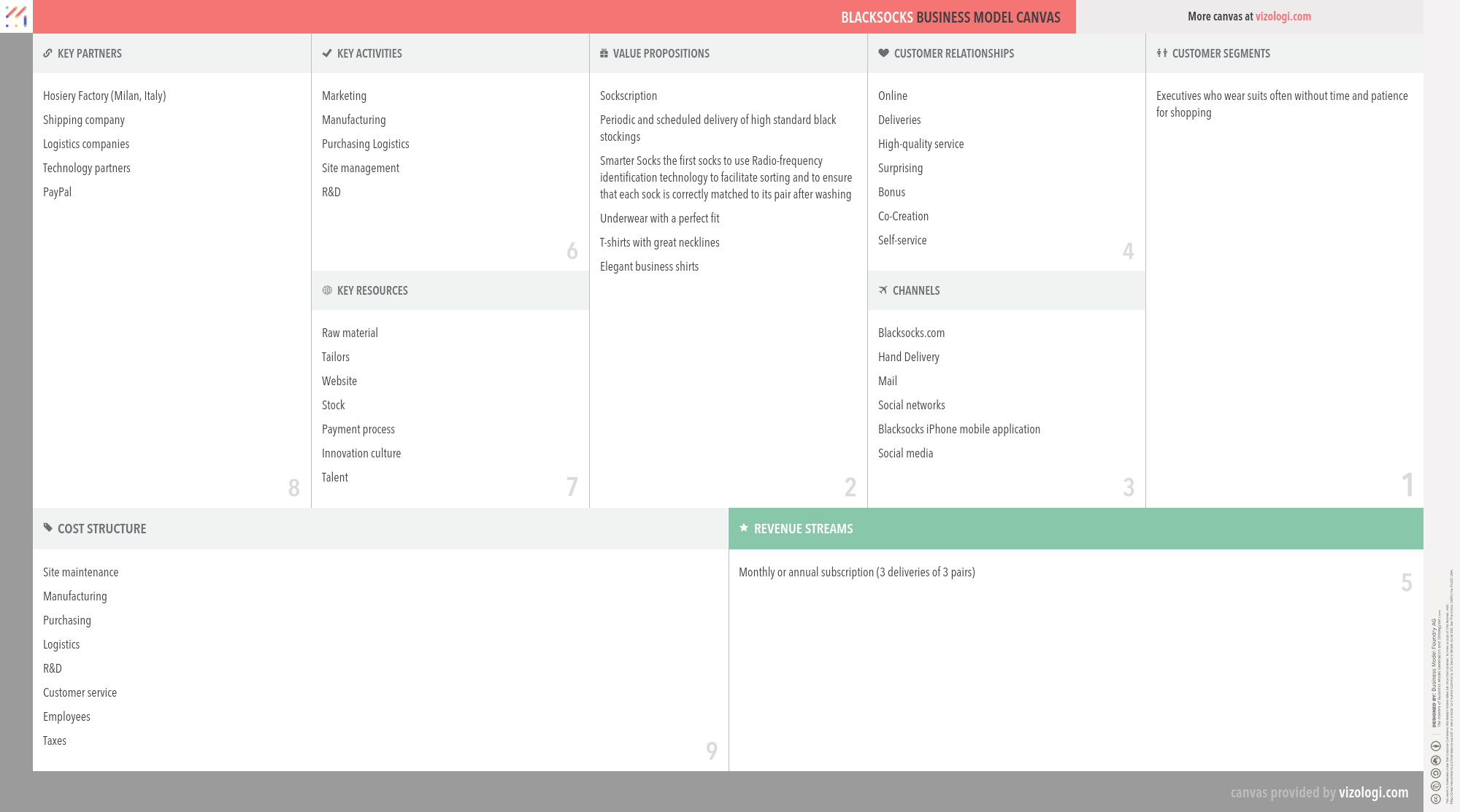Why Blacksocks's Business Model is so successful?
Get all the answers 
Blacksocks’s Company Overview
Blacksocks is a European sock subscription service and online retailer. For an annual subscription price, customers receive three pairs of socks three times a year. The socks come in a limited variety of sizes and styles, with options such as calf socks, knee socks, and silk cashmere socks. The socks are manufactured near Milan, Italy using extensive manufacturing processes to ensure durability and consistency. The company has also expanded into a line of underwear and t-shirts, as well as offering athletic and ski socks. Blacksocks has 60.000 active customers, primarily in France, Germany, and Switzerland, and, as of March, 2009, the company maintains a growing presence in the United States
https://www.blacksocks.com/us/en/Country: Italy, Switzerland
Foundations date: 1999
Type: Private
Sector: Consumer Goods
Categories: eCommerce
Blacksocks’s Customer Needs
Social impact:
Life changing: self-actualization, heirloom
Emotional: rewards me, design/aesthetics, badge value, attractiveness
Functional: saves time, quality, variety, avoid hassles, sensory appeal
Blacksocks’s Related Competitors
Blacksocks’s Business Operations
Cash machine:
The cash machine business model allows companies to obtain money from sales since consumers pay ahead for the goods they purchase, but the costs required to generate the revenue are not yet paid. This increases companies' liquidity, which they may use to pay off debt or make additional investments. Among several others, the online store Amazon often employs this business model.
Corporate innovation:
Innovation is the outcome of collaborative creativity in turning an idea into a feasible concept, accompanied by a collaborative effort to bring that concept to life as a product, service, or process improvement. The digital era has created an environment conducive to business model innovation since technology has transformed how businesses operate and provide services to consumers.
Direct selling:
Direct selling refers to a situation in which a company's goods are immediately accessible from the manufacturer or service provider rather than via intermediate channels. The business avoids the retail margin and any extra expenses connected with the intermediaries in this manner. These savings may be passed on to the client, establishing a consistent sales experience. Furthermore, such intimate touch may help to strengthen client connections. Finally, direct selling benefits consumers by providing convenience and service, such as personal demonstrations and explanations of goods, home delivery, and substantial satisfaction guarantees.
eCommerce:
Electronic commerce, or e-commerce (alternatively spelled eCommerce), is a business model, or a subset of a larger business model, that allows a company or person to do business via an electronic network, usually the internet. As a result, customers gain from increased accessibility and convenience, while the business benefits from integrating sales and distribution with other internal operations. Electronic commerce is prevalent throughout all four main market segments: business to business, business to consumer, consumer to consumer, and consumer to business. Ecommerce may be used to sell almost any goods or service, from books and music to financial services and airline tickets.
Experience selling:
An experience in the sales model describes how a typical user perceives or comprehends a system's operation. A product or service's value is enhanced when an extra customer experience is included. Visual representations of experience models are abstract diagrams or metaphors derived from recognizable objects, actions, or systems. User interfaces use a range of experience models to help users rapidly comprehend what is occurring in the design, where they are, and what they may do next. For example, a software experience model may depict the connection between two applications and the relationship between an application and different navigation methods and other system or software components.
Niche retail:
A marketing strategy for a product or service includes characteristics that appeal to a particular minority market segment. A typical niche product will be distinguishable from other goods and manufactured and sold for specialized purposes within its associated niche market. Niche retail has focused on direct-to-consumer and direct-to-business internet sales channels. The slogan for niche retail is Everything except the brand.
Subscription:
Subscription business models are built on the concept of providing a product or service in exchange for recurring subscription income on a monthly or annual basis. As a result, they place a higher premium on client retention than on customer acquisition. Subscription business models, in essence, concentrate on revenue generation in such a manner that a single client makes repeated payments for extended access to a product or service. Cable television, internet providers, software suppliers, websites (e.g., blogs), business solutions providers, and financial services companies utilize this approach, as do conventional newspapers, periodicals, and academic publications.
Subscription box:
A subscription box is a regular delivery of retail goods to a client. Thus, subscription boxes are both a marketing tactic and a delivery mechanism for products. Subscription boxes are used by subscription-based e-commerce companies, abbreviated subcom, that operates on a subscription-based revenue model. They cater to a diverse client base and address a range of particular demands and interests. Since the subscription box business is still in its infancy, there is little data available. However, between 400 and 600 distinct types of subscription boxes are available in the United States alone, with more known internationally.
Recommended companies based on your search:

